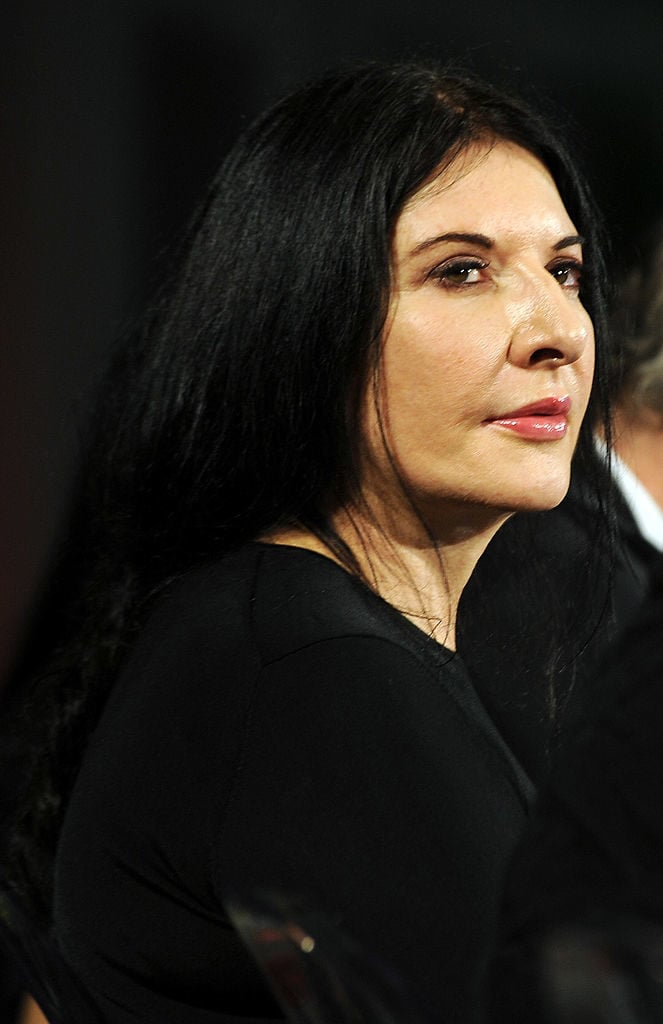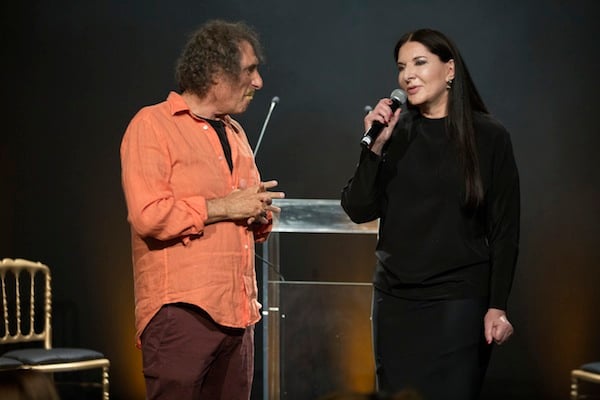
Golden brains, golden lips, and golden balls were the three focal points of last night’s Scopus Award Gala at the Campus Biotech in Geneva. The Hebrew University of Jerusalem honored British architect Norman Foster with the award, which was designed and presented by Marina Abramović.
The performance artist created a golden replica of Foster’s brain, with a custom-made “mad scientist” cap, equipped with LED lights. She explains:
I really like Norman Foster, and his sense of humor. And, he’s English, so I was thinking how to combine these things. So I thought, scan his brain. Let’s create some kind of replica of his brain itself, as a sculpture… You know, in England, every tea set has a tea cozy, so I said, let’s make a cozy for the brain, but one that can somehow create a charge or create light. It creates some kind of mad scientist idea of luminosity coming out.

Marina Abramovic presents Lord Norman Foster with the golden brain Scopus Award. Photo by David Vexelman.
Dubbed “The Golden Brain” Gala, guests also participated in a performative action called “The Golden Lips.”
As the event began, attendees were given gold-dusted chocolate molds of Abramović’s lips, and a rectangle of delicate gold leaf. They were asked to rub the gold on themselves to apply a sort of shimmering lipstick, before eating a golden ball made of almonds, black and white peppercorns, coriander seeds, honey, and 24-carat gold. (It’s a recipe she picked up while fasting with Tibetan monks.)
She explains:
In India, after a child is born, when they’re six or seven months old, they give them 24-carat gold leaf to eat, mixed with honey, because this activates his brain cells, and from early childhood they can have a very fresh memory.
In addition to Indian newborns, Abramovic has been influenced by fasting monks:
I spent lots of time in retreats, going to India, doing meditation, and learning from Tibetan monks about deprivation of food—they have this very long fasting period of 21 days. I wanted to include this into my performances, because sometimes for my performances I don’t eat. The longest I didn’t eat was 16 days, only water. I never actually succeeded to do 21 days, it’s very difficult, and dangerous in many ways. After not eating for 21 days, they eat this golden ball in order to nourish the system. I learned to make this golden ball from them.

The Scopus Gala took place at the Campus Biotech in Geneva. Photo by David Vexelman.
Before any guests could activate their brain cells with 24 carats, however, Abramović had to get acquainted with Geneva’s scientific scene. The day before the gala, Kreëmart founder Rafael Castoriano drove Abramović to the Campus Biotech to scope out the event space. As he yelled out the window to a stranger about a parking spot, a scraggly-haired man pulled up on the right, offering a spot in the garage. It was Professor Idan Segev, head of the department of Neurobiology at the Hebrew University, and he recognized Abramović through the window.
The scientist and artist were eager to interview each other about brain waves before they even get out of their cars, and their conversation continued into the night. At a cocktail party later that evening, Abramović nearly hid from other guests in order to continue contemplating with Segev everything from Einstein’s theory of special relativity, to synchronicity, the origins of creativity, and the practice of certain monks who can raise their body temperature by meditating.

A golden-lipped professor Idan Segev, and Marina Abramovic at the Scopus Gala. Photo by David Vexelman.
Segev isn’t the first brain scientist to capture Abramović’s attention, however. She says that after she completed The Artist is Presentperformance at the Museum of Modern Art in New York in 2010:
American and Russian scientists got interested in my brain, because I was the best guinea pig ever… I can be so long motionless, and they needed volunteers for this kind of experiment.
In 2011, Abramović collaborated with the Sackler Institute for Developmental Psychobiology on Neuroscience Experiment I: Measuring the Magic of the Mutual Gaze. The artist tells artnet News that she spent a year under the gaze of researchers, who measured her brain waves while she locked eyes with strangers. Much like the Mutual Wave Machine, a project presented by the Marina Abramović Institute in 2013, the project explored the extent to which two people can communicate nonverbally.
“It looks like the brain, in nonverbal conversation, can produce lots of waves and activities that we are not aware of,” she says. “I am fascinated about the brain, because it’s such unknown territory.”
Follow artnet News on Facebook.
No comments:
Post a Comment